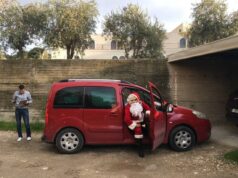In recent years, the name Yemen’s Houthi has emerged, no less popular than Palestinian Hamas, Lebanese Hezbollah, or ISIS (NIIS) in Iraq and Syria. In fact, previously, the international world did not know anything about the Houthis. The public began to recognize the Houthi group when they emerged as opposition to Yemeni President Ali Abdullah Saleh in 2003, and especially since 2011, when they joined forces with other groups in the “Yemeni Intifada (Revolution)” movement to overthrow the government and demand the president’s resignation.
In the Middle East (Middle East), Saleh is one of the longest-serving presidents. He has been president since 1977. First as President of the Yemen Arab Republic (North Yemen) and after North Yemen and South Yemen united to form the Republic of Yemen in 1990, he was again president until 2012 when he stepped down in the aftermath of the intifada. Now, the name of Houthi is back in the spotlight due to its involvement in the “Red Sea conflict” with the United States (US) and Britain.
Origins of the Houthis
According to Ahmed Addaghashi, a professor at Sana’a University (Yemen), the Houthi movement is rooted in Syabab al-Mu’minin, a theological-religious organization of young people affiliated with the Zaidi Shia, aimed at promoting, disseminating, and reviving the teachings of this Islamic sect to society at large.
The youth organization founded by the Houthi family was established in the early 1990s, after the unification of South Yemen and North Yemen. To attract teenagers and young people, Syabab al-Mu’minin held a number of programs, such as a summer camp by presenting a number of populist Shia figures, such as Muhammad Hussein Fadhlallah (Lebanese Shia cleric) or Hassan Nasrallah (leader of Lebanese Hezbollah ) which succeeded in attracting tens of thousands of participants. So, the Houthis were not originally a political group.
Among the important figures from the Houthi family is Hussein al-Houthi. The current name of the Houthi movement was taken or adopted by the followers and loyalists of Hussein al-Houthi (also called hutiyyun) after he was killed at the hands of government officials in 2004 because he was accused of treason and separatism.
The official name of this group is actually Ansar Allah. Meanwhile, the name “Houthi” is the name of a sub-tribe or variant of the Bani Hamdan, one of the main Ismaili Shiite tribal groups that ruled North Yemen in the 12th century before being conquered by Turan Shah. , brother of Salahuddin al-Ayyubi (1193), legendary Kurdish-Sunni leader and founder of the Ayub Sultanate. The Ayub dynasty only ruled North Yemen for a few years. A Shia group (this time Zaidiyah) from various factions, tribes, and clans returned to power centuries later until 1962 when a civil war broke out that ended the domination of the “Zaidiyah regime”.
During his lifetime, Hussein al-Houthi was suspected to have been a member of the council (1993-1997) of Hizb al-Haqq, an Islamic political party affiliated with Shia Zaidiyah, which managed to obtain two legislative seats during the first post-unification election held in 1993. In the following election (1997), Hizb al-Haqq lost its council seat as it only received 0.2 percent of votes. This caused the political party to form a coalition with the opposition party, which also failed to obtain seats in the 2003 election because they only received 0.1 percent of the vote.
Houthi-Government Conflict
Although he does not have official relations and affiliation with the Syabab al-Mukminin organization, Hussein al-Houthi is considered to have a central role in the militant, radical, and ideological indoctrination of some members of this organization, or Zaidi followers in general.
In 2003, as a response to the US annexation in Iraq, Hussein al-Houthi began leading a series of mass actions while carrying symbols (and shouting slogans) against the US and Jews. The peak was in 2004, when the government, afraid of the US-Yemen relationship being disrupted, as well as concerns about the wider impact of mass demonstrations on anti-government attitudes, finally decided to arrest hundreds of demonstrators.
Initially, President Saleh initiated a dialogue with Hussein al-Houthi, but Hussein al-Houthi refused and even responded by launching a series of attacks (known as “Houthi rebellion” which later turned into a civil war) against authorities and the central government. Eventually, the government captured (and killed) Hussein al-Houthi and hunted down his followers. Although Hussein al-Houthi had been killed and the authorities repeatedly tried to crush the Houthi movement, the group did not die out. Following his death, the Houthi movement was successively led by his father (Badruddin al-Houthi, a politician and Zaidi Shia scholar).
After the passing of their father in 2010, the group has since been led by Abdul Malik al-Houthi (brother of Hussein al-Houthi). Although the government and the Houthis have held multiple negotiations (some facilitated by Oman and Saudi Arabia), these talks have not produced a satisfactory solution for the two sides, who hold different views and stances on the state of Yemen.
The protracted conflict and civil war between the Houthi and the government (and its allies) has once again left Yemen in disarray. This is compounded by the recent United States-United Kingdom airstrike retaliating against the Houthi’s attack on commercial and military ships in the Red Sea, which was believed to potentially aid Israel. The United Nations has designated Yemen as one of the countries with the highest and most urgent humanitarian crisis in the world, as it has caused more than 21.6 million people to live in misery.
A Number of Factors
The emergence of the Houthi movement, which has controlled parts of northern Yemen for several years, is the result of a combination of internal and external factors. Among the internal factors that have contributed to the founding of the Houthi movement, according to the group’s militant elite, are poverty and underdevelopment that have befallen the Yemeni people, as well as corruption that has plagued the government.
A series of US annexations in Iraq (and Afghanistan) or Israel in Palestine have also played a role in the formation of the Houthi movement. The influence of Hezbollah, one of the Shia militant political-religious factions in Lebanon, cannot be overlooked either. Since the 1990s, the Houthi elites have been establishing connections with Hezbollah officials despite their different Shia sects. In Timteng, Hezbollah’s influence stretches beyond Lebanon and into other regions. Previously, there was also Hezbollah Hijaz in Saudi Arabia, Hezbollah Kuwait in Kuwait, and so on.
Hezbollah was formed in the early 1980s by Shia leaders in Lebanon who followed the late Imam Khomeini to resist Israel’s military aggression in Lebanon. It is funded and trained by Iran. Iran has also sent thousands of personnel from the Islamic Revolutionary Guard Corps to Lebanon to aid Hezbollah.
The establishment of the Houthi radical movement could also be due to the failure of the Hizb al-Haqq party to attract votes from the public in the 1997 and 2003 elections. Perhaps this failure to fight through political means pushed Hussein al-Houthi and his loyalists to choose the “short path” of insurgency through physical resistance and armed rebellion in order to control northern Yemen.
An equally important factor is the desire to carry out a “revivalism” of the authority of the political-religious Shia Zaidi power that once ruled northern Yemen for centuries after the departure of the Ayub Dynasty. Motivation to revive old political authority or power is also allegedly the reason and hidden agenda of Taqiyuddin al-Nabhani in founding Hizbut Tahrir in the early 1950s, namely to realize the return of his ancestral power (Bani Nabhan), namely the Nabhani Dynasty (Daulah Nabahina) that once ruled over some parts of the Timteng region (especially Oman) for several centuries after successfully overthrowing the Bani Saljuk.
Shia Diversity
The Houthi are just a small part of the many and diverse Shia stories in Yemen and the Middle East in general. Shia followers in Yemen comprise approximately 30-35 percent of the population. The remaining 65-70 percent are Sunni-Shafi’i. Although the majority of Shia in Yemen are Zaidiyah, other Shia groups such as Imamiyah (Twelver) and Ismailiyah (Ismaili) also exist.
The dominance of Zaidiyyah in Yemen is interesting and “special” because the majority of Shia in the Middle East are followers of Imamiyah. In addition to Yemen, other Middle Eastern countries with significant Shia populations are Iraq, Lebanon, Bahrain, and Saudi Arabia.
In addition to these three Shia groups, there are several other Shia variations residing in various areas in Timteng, such as Ismaili Nizari, Mustaali Dawoodi Bohra, Alawi, and Sulaimani Bohra. In Medina (Saudi Arabia), there is a group of Shia followers who call themselves Nakhawila.
Followers of Zaidiyah not only reside in Yemen, but also in the southern region of Saudi Arabia, such as Najran which borders Yemen. Like Sunnis, Shiites also have diverse aspects of teachings, doctrines, traditions, cultures, ethnicities of followers, ritual practices, understanding and discourse of religion, political affiliations, and other such factors.
For example, in the context of the Houthis, even though this group is affiliated with Zaidiyyah, it does not mean that all Shia followers support the Houthi movement. Many of them are against the vision, mission, platform, strategy, tactics, and violent practices of the Houthis. For example, recruiting children as militias, taking civilians hostage, and so on.
Will the Houthi be able to realize their dream of resurrecting the supremacy of the “Zaidi Dynasty” in Yemen? Without significant support from the majority Sunni population of Yemen and the international community, it seems that the Houthi dream remains just a dream.
Note: this article was previously published in Kompas on 25 January 2024.








